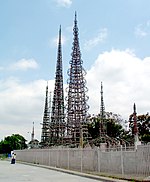103rd Street/Watts Towers station
1990 establishments in CaliforniaA Line (Los Angeles Metro) stationsCalifornia railway station stubsLos Angeles County, California geography stubsLos Angeles Metro stubs ... and 2 more
Railway stations in the United States opened in 1990Wikipedia page with obscure subdivision

103rd Street/Watts Towers station is an at-grade light rail station on the A Line of the Los Angeles Metro Rail system. The station is located alongside the Union Pacific freight railroad's Wilmington Subdivision (the historic route of the Pacific Electric Railway), at its intersection with 103rd Street, after which the station is named, along with the nearby landmark Watts Towers in the Watts neighborhood of Los Angeles, California.It is adjacent to the Watts Station, which historically served the Watts, Long Beach, and San Pedro lines of the Pacific Electric Railway.
Excerpt from the Wikipedia article 103rd Street/Watts Towers station (License: CC BY-SA 3.0, Authors, Images).103rd Street/Watts Towers station
Grandee Avenue, Los Angeles Watts
Geographical coordinates (GPS) Address Nearby Places Show on map
Geographical coordinates (GPS)
| Latitude | Longitude |
|---|---|
| N 33.9427 ° | E -118.2432 ° |
Address
Grandee Avenue
90059 Los Angeles, Watts
California, United States
Open on Google Maps





